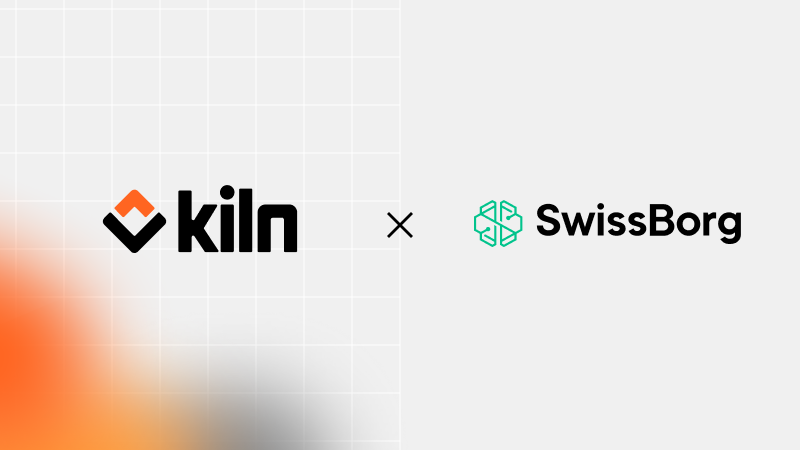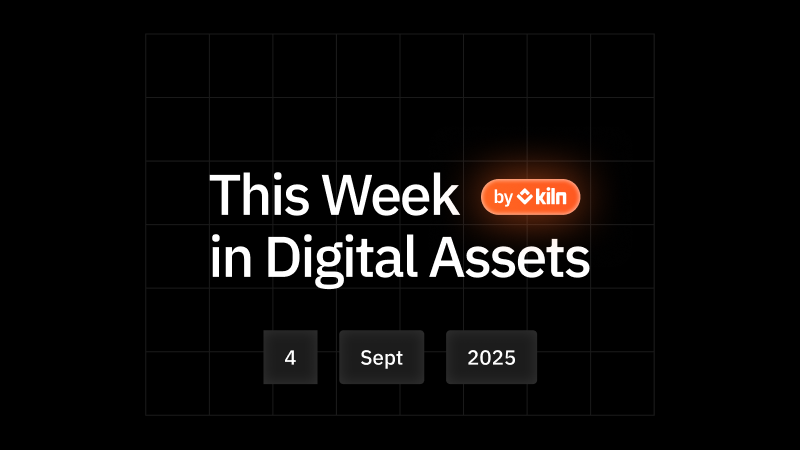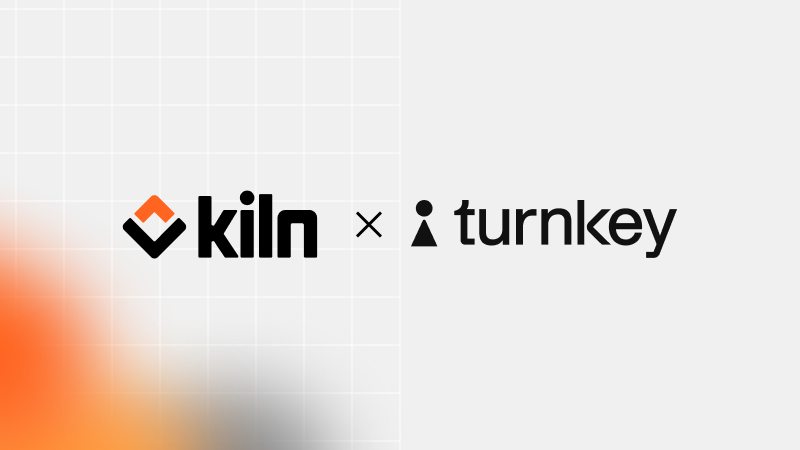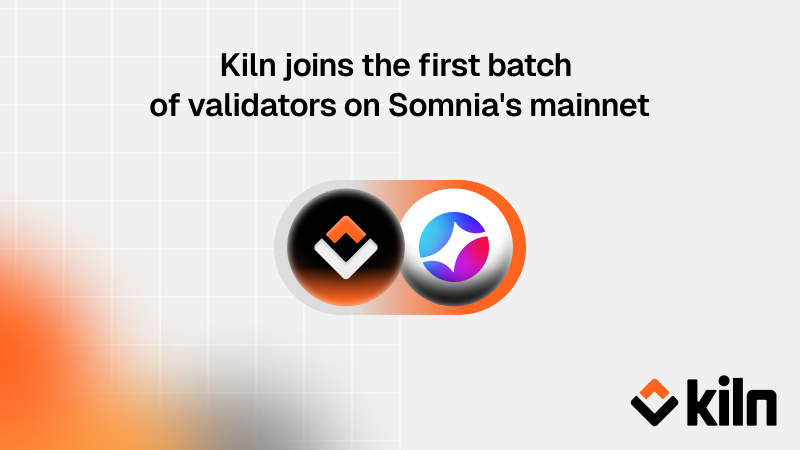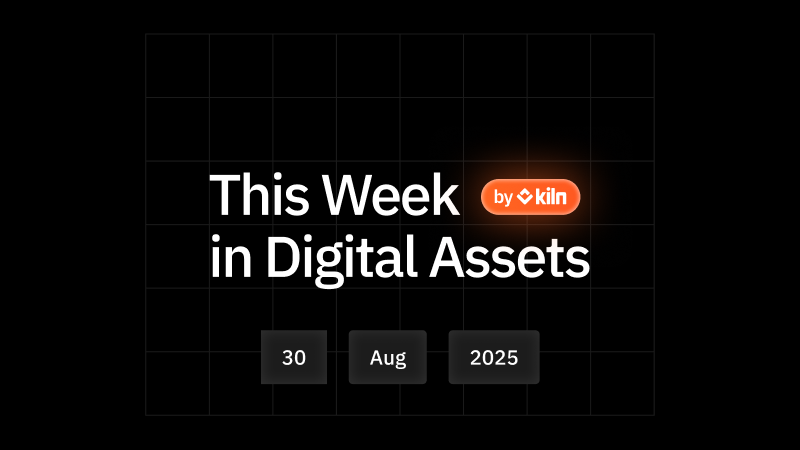EigenLayer is a collection of smart contracts built on Ethereum. It enables ETH stakers to increase the utility of their stakeby participating in securing additional services than Ethereum, known as AVSs (Actively Validated Services).
By opting in, stakers can "restake" their staked ETH to validate various AVSs, such as “sidechains, data availability layers, new virtual machines, keeper networks, oracle networks, bridges, threshold cryptography schemes, trusted execution environments”, as described by EigenLabs. This gives restakers the chance to earn additional rewards from AVS-generated fees.
EigenLayer helps builders establish their own trust networks, as they can leverage the security and decentralization provided by ETH restakers through EigenLayer.
At Kiln, we’ve actively maintained all major EigenLayer AVSs from day one and continue to enhance our support with ongoing updates. Additionally, in our commitment to our community of delegators, we ensure transparency by sharing any airdrops received.
In this blog post, we explore the AVS ecosystem, highlighting its key players, innovations, and their impact on the Ethereum landscape. Through the Restaking Club explorer, you can easily access on-chain data on AVSs, including TVL, assets, number of restakers, and volume per operator.
Which are the various EigenLayer AVSs?
EigenDA
EigenDA is EigenLayer’s first AVS that allows users to manage data availability effectively. It supports data handling up to 10 MB/s and introduces a dual quorum staking model. This model gives users more control by letting them establish a custom quorum based on their token holdings in addition to the standard Ethereum quorum. Users can also pay for services with native tokens and reserve bandwidth to manage costs effectively. Don't miss our podcast interview with Teddy Knox, a Research Engineer at EigenLayer, as he discusses EigenDA's groundbreaking features.
Check out their activity over time using the Restaking Club Operator.
AltLayer
AltLayer enhances the Ethereum ecosystem by facilitating the deployment of application-specific chains using roll-ups. This technology moves execution off the Ethereum base layer, allowing for greater customization. AltLayer offers Roll-up as a Service (RaaS) to ease the deployment process, particularly for developers new to roll-up technology.
Discover more in our podcast with AltLayer’s COO Amrit Kumar.
Explore their historical activity with the Restaking Club Operator.
Lagrange
Lagrange, tailored for optimistic rollups within the EigenLayer ecosystem, provides a state committee AVS with a light client mechanism. This setup reduces confirmation times and improves security by involving a large number of Ethereum validators.
Insights on Lagrange's operation and benefits are discussed in our podcast with CEO Ismael Hishon-Rezaizadeh.
Check out their activity over time using the Restaking Club Operator.
Witness Chain
Witness Chain addresses trust issues in blockchain protocols by implementing watchtowers that monitor and ensure transaction integrity. This AVS is particularly useful for optimistic rollups and DePIN projects, providing enhanced security across various blockchain architectures.
Learn how this technology works in our podcast with co-founder Himanshu Tyagi.
Check out their activity over time using the Restaking Club Operator.
Brevis
Brevis, a ZK coprocessor, extends smart contract functionalities by allowing them to process extensive historical data across supported blockchains. This enhances computations without compromising data security or privacy.
Learn more about Brevis in our podcast with Wanli Zhou, Head of Ecosystem.
Track their performance with the Restaking Club Operator.
Omni Network
Omni serves as an interoperability protocol within the Ethereum ecosystem, creating low-latency channels for communication between various Ethereum rollups. This facilitates a unified network, enhancing security and performance globally.
Dive into their performance with the Restaking Club Operator.
Eoracle
Eoracle acts as a programmable data layer bridging smart contracts and real-world data, enhancing security and interoperability over traditional centralized oracles.
Dive deeper into eoracle's innovative approach in our podcast with founder Matan Si.
Use the Restaking Club Operator to analyze their past activity.
Xterio MACH
Xterio MACH utilizes AltLayer's technology to secure its game-focused blockchain. It supports dual staking of ALT tokens and other assets, boosting security and user engagement.
Stay updated on their performance through the Restaking Club Operator.
Hyperlane
Hyperlane facilitates seamless communication and asset transfers across different blockchains, incorporating a mailbox, security modules, and a relayer to ensure secure and efficient operations.
Discover more about Hyperlane in our podcast with co-founder Jon Kol.
Track their historical performance with the Restaking Club Operator.
Blockless
Blockless supports developers in creating off-chain functionalities without sacrificing security. It operates on a sophisticated algorithm for optimal node selection to execute workloads.
Gain insights from our conversation with co-founder Michael Chen.
Check out their activity over time using the Restaking Club Operator.
Silence Laboratories
Silence Laboratories focuses on developing privacy-centric solutions, utilizing Multi-Party Computation (MPC) to enable secure data analysis and sharing.
Join our podcast with CEO Jay Prakash for an in-depth discussion on their technology and roadmap.
Restake your assets with Kiln product suite
While EigenLayer restaking is available through our suite of products, you can directly restake with Kiln via the EigenLayer operator tab. Maximize your staking returns with a secure validator.
Kiln dApp
EigenLayer staking is available to everyone through our native 1-click EigenLayer restaking functionality on Kiln dApp.
With the recent EigenLayer mainnet launch, anyone can use the Kiln dApp to effortlessly stake and delegate to AVSs batches of 32 ETH or LSTs with just one click. Just connect your wallet and begin earning EigenLayer restaked points. Learn more about restaking on Kiln dApp.
Check out our brief 2-minute demo videos for clear, step-by-step instructions on restaking through Kiln dApp!
Kiln Dashboard
Designed for our institutional customers, the Kiln Dashboard seamlessly integrates with established custody solutions like Fireblocks, Copper, and Fordefi. This allows companies with larger treasuries to restake their ETH through a familiar and secure environment.
It is worth noting that delegation of your restake to AVSs will be available soon on the Kiln Dashboard. Take a look at our 2-minute demo video to see the process.
Kiln Connect
Kiln Connect empowers enterprises to offer a white-labeled restaking experience to their users. It takes care of the complex technical details behind the scenes, allowing institutions to focus on delivering a seamless user experience. When a user wants to restake their assets, Kiln Connect:
- Checks which assets are eligible for restaking.
- Helps prepare the necessary steps for a secure transaction.
- Provides all the information needed to complete the restaking process.
By leveraging Kiln Connect, enterprises can empower their users to participate in restaking and potentially earn additional rewards, all within the familiar environment of their platform.
Kiln On-Chain
Beyond the current options, Kiln On-Chain will soon provide pooled restaking. This feature will empower users to restake any amount of ETH, not just the traditional minimum of 32 ETH required for running a full validator. This opens the door for a wider range of users to participate in securing the EigenLayer AVSs.
Stay tuned! We'll be sharing more details about the pooled restaking feature on Kiln On-Chain soon.
What is the future for EigenLayer and AVSs post-mainnet?
EigenLayer's emergence as a restaking protocol for Ethereum presents a future filled with both exciting opportunities and uncertainties for the Ethereum ecosystem. Here's a breakdown of both:
Opportunities:
- Enhanced scalability and security: By enabling restaking of ETH for AVSs, EigenLayer unlocks additional capital for securing the network. This paves the way for a more scalable and secure Ethereum, capable of supporting a wider range of applications.
- Experiment with AVSs without slashing risk: In the initial stages of EigenLayer, there's currently no slashing mechanism; this allows restakers and operators to explore and participate in various AVSs without the fear of penalty in case those AVSs encounter issues. It's a great opportunity to experiment and potentially earn points from multiple AVSs. Slashing mechanisms will be implemented in the future, so staying informed about AVS developments is recommended.
- Innovation in DeFi and Web3: The diverse functionalities offered by AVSs can fuel innovation in DeFi and Web3. Imagine efficient sidechains, robust data availability layers, and secure Oracle networks – all contributing to a richer and more versatile Ethereum landscape.
- Increased staking participation: EigenLayer allows stakers to earn additional rewards by participating in AVS validation. This could incentivize more users to participate in staking, further strengthening Ethereum's security.
- A more vibrant ecosystem: The interplay between stakers, operators, and AVS developers can create a dynamic and competitive ecosystem. This fosters innovation, attracts talent, and ultimately benefits users with a wider range of choices and potentially better returns.
Uncertainties:
- Security risks: The EigenLayer network is still young. Mitigating security risks associated with AVSs, especially before slashing is fully implemented, remains a challenge.
- AVS adoption and competition: While a diverse AVS landscape is promising, it's still being determined which AVSs will gain traction and how competition will play out. Unforeseen vulnerabilities or inefficiencies in specific AVSs could pose risks.
- Economic sustainability: Establishing a long-term economic model that incentivizes all participants – stakers, operators, and AVS developers – is vital. Finding the right balance between rewards and fees will be crucial for the ecosystem's health.
- Centralization concerns: If a limited number of operators control a large portion of the network, it could lead to centralization risks. Measures to encourage a diverse operator pool are essential.
The future of the EigenLayer ecosystem has great potential. However, addressing the uncertainties mentioned above will be critical for its long-term success. If these challenges are tackled effectively, EigenLayer has the potential to be a game-changer for Ethereum, propelling it towards a more secure, scalable, and innovative future.
About Kiln
Kiln is the leading enterprise-grade staking platform, enabling institutional customers to stake assets and whitelabel staking functionality in their offerings. Kiln runs validators on all major PoS blockchains, with over $7.5 billion in crypto assets being programmatically staked and running over 4% of the Ethereum network on a multi-client, multi-cloud, and multi-region infrastructure. Kiln also provides a validator-agnostic suite of products for fully automated deployment of validators and reporting and commission management, enabling custodians, wallets, and exchanges to streamline staking operations across providers. Kiln is also SOC2 Type 2 certified.
About Kiln
Kiln is the leading staking and digital asset rewards management platform, enabling institutional customers to earn rewards on their digital assets, or to whitelabel earning functionality into their products. Kiln runs validators on all major PoS blockchains, with over $11 billion in crypto assets being programmatically staked and running over 5% of the Ethereum network on a multi-client, multi-cloud, and multi-region infrastructure. Kiln also provides a validator-agnostic suite of products for fully automated deployment of validators and reporting and commission management, enabling custodians, wallets, and exchanges to streamline staking or DeFi operations across providers. Kiln is SOC2 Type 2 certified.











